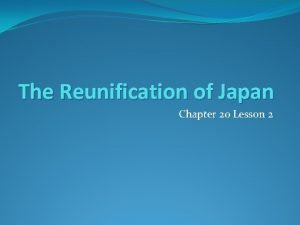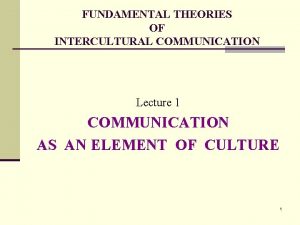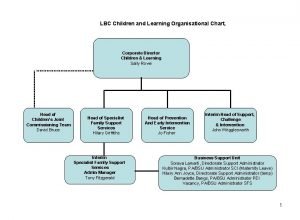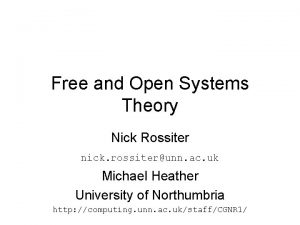Karen Woodall and Nick Woodall Reunification work Experiences























- Slides: 23

Karen Woodall and Nick Woodall Reunification work: Experiences from London

Reunification • What: We reunite children - not in the distant future but as swiftly as we can • Why: To heal the psychological splitting - because pathological splitting is the root parental alienation • How: We use the power of the court to neutralise the power of the alienating parent and reunite the child with the rejected parent immediately

Parental alienation is a relational issue ‘Attachment theory emphasizes (…) the primary status and biological function of intimate emotional bonds between individuals, the making and maintaining of which are postulated to be controlled by a cybernetic system situated within the central nervous system, utilizing working models of self and attachment figure in relationship with each other. ’ Bowlby, J. (1988). A secure base: Clinical applications of attachment theory. New York: Brunner. Routledge.

The post separation landscape • In the intact family, the child has a unified attachment experience • In the post separation family, the child has to find a way to maintain the unique attachment bonds in a fractured relational world • A child who experiences pressure in their inter-psychic world is a child who is at risk of pathological splitting

Identification with the aggressor ‘Ferenczi (1933) found evidence that children who are terrified by adults who are out of control will “subordinate themselves like automata to the will of the aggressor to divine each one of his desires and to gratify these; completely oblivious of themselves they identify themselves with the aggressor. . The weak and undeveloped personality reacts to sudden unpleasure not by defence, but by anxiety-ridden identification and by introjection of the menacing person or aggressor”’ Frankel, J. (2002). Exploring Ferenczi's Concept of Identification with the Aggressor: Its Role in Trauma, Everyday Life, and the Therapeutic Relationship. Psychoanalytic Dialogues, 12: 101 -139

Identification with the aggressor ‘Bowlby (1982) observed a pattern of insecure attachment he termed compulsive self-reliance, in which a “parentified” child assumes care-giving responsibilities toward the parent. Bowlby hypothesized that, because of their insecurity about the emotional availability of others, some parents turn to their children to meet their own emotional needs, placing developmentally inappropriate demands on young children to provide their parents with nurturance and comforting. Although the parent may be ostensibly protective and solicitous, parentification has negative implications for child development in that the parents’ emotional needs are being met at the expense of the child’s. ’ Kerig, P. K. (2005). Implications of parent-child boundary dissolution for developmental psychopathology: Who is the parent and who is the child? New York: Haworth Press.

Identification with the aggressor 'By identifying with the aggressor, the child preserves the self as powerful and disowns the weak self representation. At the same time, identification with the aggressor can preserve the object by allowing the victim to maintain an internalized image of the abuser, and thereby avoid abandonment by the abusive attachment object. ' Blizard, R. A. (1997, November). The origins of dissociative identity disorder from an object relations and attachment theory perspective. Paper presented during the workshop, Effective Psychoanalytic Technique and Its Theory in Treatment of Dissociative Identity Disorder, International Society for the Study of Dissociation, Montreal.

Identification with the aggressor • When the child feels that the attachment bond is threatened, they pathologically align with the threatening parent in order to avoid abandonment • They split off the threatened part of themselves and the abusive patent as a separate object representations. • Anything that threatens to force the child to confront the split off object must be repelled in order for the child not to have to face the trauma of recognising the attachment object as being abusive.

Generic therapy is not the answer ‘most helping services are designed to “blame” one family member and seek to organise, change or ameliorate that person’s behaviour, beliefs or feelings. For this reason early family therapists warned against family therapy becoming part of mental health services. Contrary to many such approaches to therapy, family therapy always places individual’s beliefs, behaviours and emotions in context. In doing so, it either dilutes blame or seeks to escape blaming interventions. ’ Rivett, M. and Street, E. (2009). Family therapy: 100 key points & techniques. Hove: Routledge.

Generic therapy is not the answer Build parental capacity to mentalise Construct coherent narrative about contact Construct coherent narrative about life events Desensitise child to nonresident parent

Generic therapy is not the answer 'the “Mr. (Mrs. ) good-guy” approach, so important in traditional individual and family therapy, has no place in the treatment of PAS families. Only therapists who are comfortable with stringent and authoritarian treatment procedures should be involved in conducting therapy with PAS families. ’ Gardner, R. A. (1999). Family therapy of the moderate type of parental alienation syndrome. The American Journal of Family Therapy, 27, 195 -212.

Practitioners have to be prepared to override the voice of the child ‘Children align themselves with the parent they most fear, or the parent they regard as most unstable (…) [a]lthough these children may be outspoken in their custodial preferences, their wishes may not reflect their genuine best interests (…) Giving children's wishes and feelings paramount weight in determining the outcome of such cases burdens children with the terrible responsibility and impossible task of managing the adult world around them. Warshak, R. A. (2003). Payoffs and pitfalls of listening to children. Family Relations, 52, 373 -384.

How we do it • Act as expert witnesses • Assess and treat the cases we work with • Differentiate using ‘therapeutic trial’ • Use the ‘can they/can’t they test’ - get the alienating parent to do what they do not want to do

How we do it • Use the court to shift the power dynamic and gets us to the alienated child • Hands us the power to make the alienating parent do what they don’t want to do – bring the child to see the rejected parent • Uses all of the legal consequences available to make that happen

How we do it • Remove the burden of choice from the child • Explain what is going to happen • Confront the child with the split off and denied object (rejected parent)

Two routes to how we do it • Assessment and Therapeutic Trial – No Personality Disorder Present • We observe the child with the rejected parent in week one • We test the evidence of the capacity of the alienating parent to make immediate behavioural change

Assessment and Therapeutic Trial • We support the rejected parent and work in a ‘co-therapy’ relationship with them • We keep confronting the child with the split off object – rejected parent • We contain, control, educate and scrutinise the alienating paren • We monitor the child’s resilience

Change of residence – personality disorder present • Psychological evaluation • Presence of shared delusional disorder • Removal of child from source of harm • Immediate reunification in the rejected parent’s home

How we do it • Override the child’s who says no • In some cases using the police or social workers • Hold the split for the child by being the person who says ‘we will do this’

2017/18 • 12 children using residence transfer • 14 children using ATT • Trained 4 psychologists in USA • Trained 4 new practitioners in Europe • About to train 12 psychologists in Australia

Moving Upstream Addressing the Problem of Parental Alienation in Europe Legal and Mental Health Conference London 30 th & 31 st August 2018 #EAPAP 2018 www. eapap. eu

www. familyseparationclinic. com

 Susan woodall
Susan woodall Nick woodall
Nick woodall Lesson 2 the reunification of japan
Lesson 2 the reunification of japan Fault line taguig
Fault line taguig Raptor reunification
Raptor reunification Section 4 review physical science
Section 4 review physical science What are the characteristics of a good research
What are the characteristics of a good research Guiding play and puppetry experiences
Guiding play and puppetry experiences Comparative development experiences of india and china
Comparative development experiences of india and china Why do we make use of contrived experiences
Why do we make use of contrived experiences The totality of a groups thought experiences and patterns
The totality of a groups thought experiences and patterns Direct and purposeful experiences
Direct and purposeful experiences Hard work and smart work
Hard work and smart work Work energy theorem
Work energy theorem Karen and sharon sanders
Karen and sharon sanders Jon snow golden ratio
Jon snow golden ratio Carmen fought
Carmen fought Karen ross and the value of speaking up
Karen ross and the value of speaking up Karen and miles
Karen and miles Realeff effect in complete denture
Realeff effect in complete denture Lbc organizational chart
Lbc organizational chart Sarah wahl
Sarah wahl Asis conference
Asis conference Disadvantages of buffet
Disadvantages of buffet












































